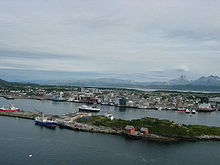Bodø: Difference between revisions
No edit summary |
|||
| Line 83: | Line 83: | ||
*[[Geir Lundestad]] |
*[[Geir Lundestad]] |
||
*[[Runar Berg]] |
*[[Runar Berg]] |
||
*[[Bjørn Jervås]] |
|||
== External links == |
== External links == |
||
Revision as of 13:23, 8 March 2007
Bodø Municipality
Bodø kommune | |
|---|---|
|
| |
 {{{map_caption1}}} | |
| Country | Norway |
| County | Nordland |
| District | Salten |
| Administrative centre | Bodø |
| Government | |
| • Governor (2005) | Odd-Tore Fygle (Ap) |
| Area | |
| • Total | 1,392 km2 (537 sq mi) |
| • Land | 1,308 km2 (505 sq mi) |
| • Rank | #62 in Norway |
| Population (2006) | |
| • Total | 45,405 |
| • Rank | #14 in Norway |
| • Density | 49/km2 (130/sq mi) |
| • Change (10 years) | |
| Official language | |
| • Norwegian form | Bokmål |
| Time zone | UTC+01:00 (CET) |
| • Summer (DST) | UTC+02:00 (CEST) |
| ISO 3166 code | NO-1804[2] |
| Website | Official website |
lat_seclon_seclon_minlat_deglon_deglat_min
Bodø is a city and municipality in the county of Nordland, Norway.
The name
The municipality is named after the old farm Bodøgård (Norse Boðvin), since the town is built on its ground. The first element is (maybe) boði m 'sunken rock, skerry', the last element is vin f 'meadow, pasture'. The last element was later misunderstood as øy f 'island' (and written with the Danish form ø).
Coat-of-arms
The coat-of-arms is from modern times (1959). It shows the Sun (to represent the Midnight Sun).
History

Bodø was granted township status in 1816 and is now county capital of Nordland. Most of Bodø was destroyed during a German attack on the 27th of May 1940. 6000 people were living in Bodø, and 3500 people lost their homes in the attack. 15 people lost their lives during the air attack (2 British soldiers and 13 Norwegians). Due to the acute lack of housing, the Swedish government helped build 107 apartments in the winter of 1941. These houses were built tightly together just outside the town. This small area, today in the heart of Bodø, is still called "svenskebyen:" the Swedish town.
The town was subsequently rebuilt after the war. The rebuilding ended in 1959 with the completion of the new town hall.
Bodø received international attention during the U-2 Crisis in May 1960, when it became known that the American U-2 pilot Gary Powers had been shot down over the Soviet Union on his way from Pakistan to Bodø.
Bodø is the home to a major NATO airbase and airforces regularly exercise during winter months during Exercise Strong Resolve.
Since 2005 Bodø has included the formerly separate municipality of Skjerstad.
Geography

The city lies just north of the Arctic Circle and the midnight sun is visible from June 2 to July 10.
The strongest tidal current in the world Saltstraumen is situated some 30 km east of Bodø.
Located on an unsheltered peninsula in the Norwegian Sea, Bodø is one of Norway's most windy cities. Snow cover during winter is usually sparse, not only due to the wind, but also an effect of a mild winter climate relative to latitude with periods of rain being common in winter. Average temperature for January is -2.2°C, while July 24-hr average is 12.5°C, annual mean temperature is 4.5°C and precipitation/year is 1020 mm [3]. The coldest month on record was February 1966 with a mean of -8.9°C, and the warmest was July 1937 with a mean of 17.1°C.
As the northern terminus of Nordlandsbanen, Bodø is the northern end of the railroad network of Norway. However, travellers going further north will often switch to a corresponding bus in Fauske bound for Narvik. There is also a railway from Narvik to Kiruna in Sweden, and further into the Swedish rail network. The railway station opened in 1961. Bodø Airport lies two km outside the city centre and was opened in 1952. The airport served 1 308 000 passengers in 2004. Ferries run between Bodø and the Lofoten Islands.

Nature and hiking
Bodø is well-known for beautiful surroundings. Besides Saltstraumen, the municipality of Bodø has lots of wilderness to offer hikers. Just 10 kilometers north of Bodø lies the beautiful recreation area of Geitvågen. The area is inhabited by a large number of Sea-Eagles.
Institutions of higher learning
- Bodø University College (Høgskolen i Bodø)
Media, culture and entertainment
The local newspaper is named Avisa Nordland.
The local football club, F.K. Bodø/Glimt, play in the Norwegian First Division during the 2006 season.
The National Aviation Museum and Salten Museum are located in Bodø. Salten Museum has four exhibitions: The Lofoten Fisheries, a Sami exhibit, a Viking treasure and an exhibition about Bodø's history from 1816 to 2000.

The Bodø Cathedral was built in 1956, representing post-war architecture, whereas the Bodin Church just outside the city centre dates from the 13th century, representing a typical medieval stone church.
Bodø is host to the cultural festival "Nordland Musikkfestuke" every summer, as well as "Bodø Hardcore Festival" in early winter, the latter one being free in every aspect, and based completely on volunteers.
Notable residents
- Ola Abrahamsson, (1883-1980), painter
- Halvdan Sivertsen
- Vebjørn Tandberg
- Oscar Bodøgaard
- Adelsteen Normann
- Harald Berg
- Magnus Eliassen
- Terje Nilsen
- Ottar "Big Hand" Johansen
- Geir Lundestad
- Runar Berg
- Bjørn Jervås
External links
- The National Aviation Museum
- Salten Museum
- Tourist Information
- Nyholms Skandses Compagnie
- Bodø Airport: Facts and pictures from Avinor
- Nice pictures from Bodø
- Web-cam of Bodø harbour
- ^ "Forskrift om målvedtak i kommunar og fylkeskommunar" (in Norwegian). Lovdata.no.
- ^ Bolstad, Erik; Thorsnæs, Geir, eds. (2023-01-26). "Kommunenummer". Store norske leksikon (in Norwegian). Kunnskapsforlaget.
- ^ met.no climate




